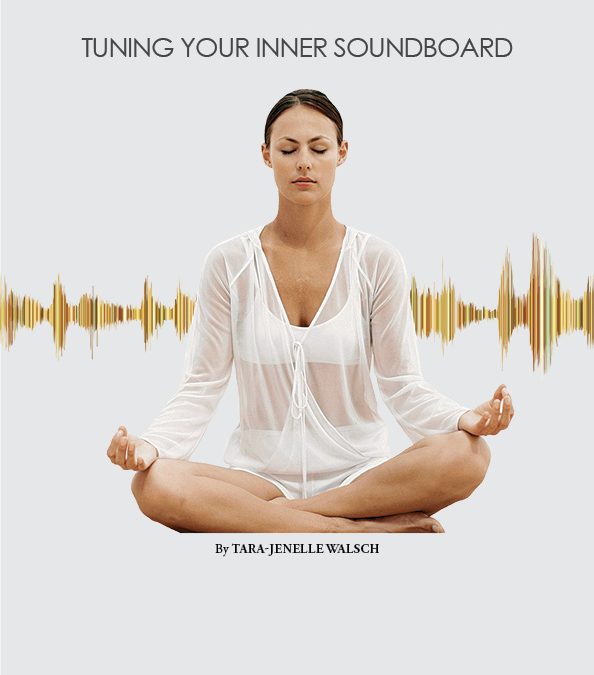By Tara-jenelle Walsch
What if you found out that your current struggles were just one big April Fools joke, played on you by the Universe?
Then, after the prank was revealed and sighs of relief were expelled, you returned to a life where the things that you now wish for and work toward were suddenly your present reality. Sure, maybe you still had some struggles, but their existence wasn’t sitting in the front row seat of your life.
Humor me for a moment; close your eyes and imagine how you would feel with the daily angst in life, lowered, and the daily joys in life, raised. Really breathe into the notion as if it were your truth.
Just the thought of it makes your heart expand, right? But if you’re anything like half of the human race, what generally follows the initial feeling of immense joy (or even feeling the possibility of immense joy) is an abrupt pause of caution.
“Not so fast!” you might even hear echoing from deep inside, as if you were caught playing hooky on your mind’s comfort zone. And suddenly all of those expansive thoughts jump back to the sensibility of realism.
Here’s the thing; we all have worries, fear, grief and pain regardless of how evolved we are. It’s part of life and unreasonable to think otherwise or make it wrong. In fact, these emotions are actually a gift. It’s important to not deny ourselves the feeling of all our emotions, even the ones we may deem shameful or were told are bad. So, the challenge is not around feeling them or not feeling them, but to not get stuck in them. To feel your emotions fully without getting lost in them.
When we become entrenched in any one emotion, the energetic weight of that emotion begins to absorb us and ultimately shields us from receiving and feeling the fullness of other emotions.
This is true even with happiness, despite the plethora of media that pushes us to be happy in every moment. Because if we are always living 100% on the high point of Happiness Mountain we’re leaving no room to experience the beauty of the opposite. We are actually blocking everything else out.
Some of you may be saying, “Great! I don’t want to experience anything other than happiness. I don’t want to feel any fear, pain, upset or lower vibrations in my life!” Yet we will come to see that, as the old saying goes, “Everything in moderation,” becomes a key element to enlightenment. The phrase does not imply to stay in the middle ground where it’s (supposedly) safe, but rather to feel all of the highs, lows and in-betweens of life and find the levels of each that best support us on our journey.
It’s almost as though life is the ultimate soundboard, and all of our emotions are the volume dials. We can use our perception of life experiences to help us strategically adjust how we carry and emit emotions, and tune ourselves into a balance that rings true to our soul.
For the sake of this analogy, let’s say that the “bass” dial is representative of our lower vibrational emotions and the “treble” dial, higher vibrational emotions. If we lifted the bass to 100% and pushed the treble dial all the way down, an imbalance would surely be reflected in our life. And likewise, if we pushed the treble dial straight up and faded the bass out, it would likely throw us out of chord. Geez, we might even bust a few speakers!
But we can create a harmonic energetic “song” (life) by adjusting the vibrational proportions of our emotions to match our ideal personal rhythm.
The flow of our ideal personal rhythm can take a detour when we stay in any one emotion too long. If it’s a lower vibrational emotion that we’re stuck in, we may begin to feel some despondence, as if we’re internally paralyzed. If it’s a higher vibrational emotion that we’re absorbed in, we may begin to feel ungrounded, as if we’re externally floating.
Let’s we break the two down and figure out how we can keep our inner soundboard harmonized: “Paralysis” is defined as the inability to act, function or move (and sometimes to feel anything) in part or most of the body, typically as a result of illness, poison, or injury.
I suspect that emotional or mental paralysis would be defined as much the same, and the “illness, poison or injury” aspect would be due to sitting in one low vibrational emotion for too long. Doing this is literally poison to our spirit and consciousness. It takes us out of the present and into the hibernation of an emotionally injured state (such as severe depression, deep grief, excessive worry, ect.).
“Floating” is defined as buoyant or suspended, ungrounded and not settled in a definite place. My experience is that emotional and mental floating (such as manic excitement, obsessive fascination around something or someone, accelerated infatuation, etc.) feels the same, energetically, as this physical definition.
But why do we get paralyzed? Typically, from fear. The uneasiness that lower vibrational emotions like grief, worry, and sadness emit can temporarily freeze hope and resign our spirits to a place of despair.
Why do we float? Typically, to escape. The blissfulness in temporarily escaping reality and responsibility is an unexpected festivity to everyday life, something that floating on any one high vibrational emotion can easily produce. It’s exhilarating to leap from a place of monotony to euphoria (“monotony” meaning that life has become commonplace and habitual, not that it’s boring).
So, what’s the soulution? Presence. In the cases of both emotional and mental paralysis and emotional and mental floating we get lost in a world of our own, almost living in a bubble. We can begin to pull ourselves out of this bubble and back into presence by asking ourselves, “What am I’m feeling?” Identifying the singular emotion that is paralyzing or floating us will immediately help to dilute any overwhelm and bring our perception of reality back into focus. Most of the time we needn’t ask ourselves, “Why am I feeling this?” That usually just takes us to a place of blame, shame or confusion.
After we identify the emotion that we are absorbed in the feeling of, we have enough awareness to adjust the sensation of that emotion by checking “back-in” to the present moment and asking ourselves, “Is this feeling in proportion to where I currently am in life right now?” This is the area where we demonstrate true loyalty to ourselves through deep honesty and courageous action. It will be our answer that propels us into an action that ultimately generates symmetry to our soundboard of life, allowing us to tune into the peaceful symphony of our soul.
Soundboard Tuning Roadmap:
1. Tune into your current vibrational frequency by sitting still and breathing with awareness. Does your energy feel high or low?
2. Identify the predominant emotion behind your energy by asking yourself, “What is it that I’m feeling?”
3. Adjust the sensation of that emotion by checking “back-in” to the present moment and asking, “Is this feeling in proportion to where I currently am right now?”
4. Be honest with yourself and use your answer to propel you into the action required to regain personal symmetry.
5. Create a habit of giving yourself “sound-checks” and listening from within to where and when your inner soundboard may be out of chord.
Tara-jenelle Walsch is a monthly columnist for the Eden Magazine. She is the author of the book, Soul Courage, and the founder and spirit behind the Soulebrate greeting card company. You will also find her speaking publicly about emotional and energetic awareness, and a sacred formula which she believes has the ability to enrich the world at large. Tara-jenelle was raised in Annapolis, Maryland and received a Bachelor of Science degree in Communications from Towson University in Baltimore. She currently lives in the beautiful hills of Ashland, Oregon with her pug, Sascha. www.soulcourage.com
Are you in a soul quandary? Feel free to ask Tara-jenelle for courageous insight. Submit your question to https://www.facebook.com/tarajenellewalsch







